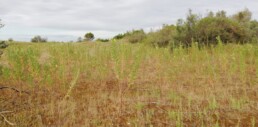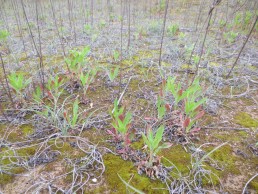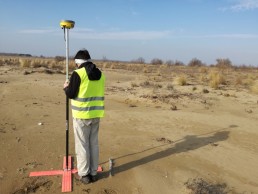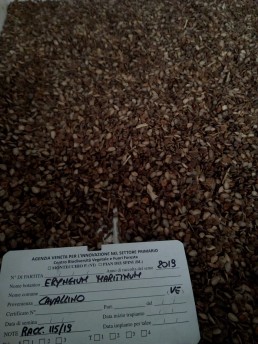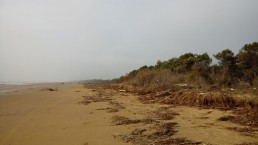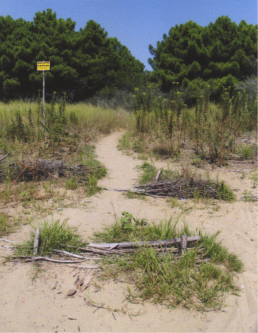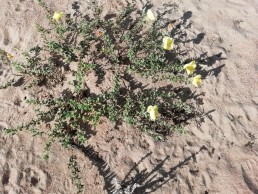Networking to preserve Adriatic coastal dune habitats
The LIFE Programme recognises the importance of "networking" and supports activities that develop relationships between individual projects that have elements in common, such as themes, methodologies, objectives, or categories of stakeholders. In this perspective, LIFE REDUNE and LIFE CALLIOPE (Coastal dune habitats, sublittoral sandbanks marine reefs: conservation, protection, and threats mitigation. Https://www.facebook.com/LifeCalliope.it), both dedicated to the protection of the coastal environment, have started at the end of December 2020 a collaboration to share results and experiences.
Both projects operate in territories where there are still some areas with dune ecosystems that are however seriously threatened by tourism activities, unsustainable fishing, alteration of their morphology and vegetation removal actions.
These problems are partly addressed by the two projects with common approaches: the reconstruction of the dune cordon, the requalification of the habitats with the transplanting of new plants produced in greenhouses and the fight against invasive species, the involvement of local authorities for an eco-sustainable territorial development and the reduction of anthropic pressure also through the environmental education of tourists and residents.
Focusing on two specific thematic aspects, LIFE REDUNE and LIFE CALLIOPE have organised two joint events to exchange information, benefit from new technical approaches and achieve greater capacity to operate at national and European level.
The webinar "Visiting nurseries: good practices from LIFE REDUNE and LIFE CALLIOPE" was dedicated to sharing knowledge on propagation techniques for mobile dune species; this webinar was held on Thursday 29 October 2020. An unexpected result of the meeting was the decision to jointly draft a "Manual of propagation of dune species" between the two projects, which aims to document the experience of nursery production of numerous species of the Adriatic coastal dune habitats, providing technical identification and cultivation sheets for each species.
The webinar "Reconstruction and monitoring of mobile dunes: good practices of LIFE REDUNE and LIFE CALLIOPE" led to the sharing of knowledge and good practices on techniques for reconstruction and rehabilitation of mobile dunes. The collaboration was also extended to the Interreg Italy-Croatia project CASCADE (CoAStal and marine waters integrated monitoring systems for ecosystems proteCtion AnD managemEnt, www.italy-croatia.eu/web/cascade) for issues related to remote monitoring of ecosystems in the project sites. This webinar was held on Friday 4 December 2020 and was live-streamed simultaneously on the Facebook pages of Life REDUNE and Life CALLIOPE.
The two webinars and subsequent contacts made it possible to establish relationships and create synergies between universities, nurseries, experts and European projects on the topic. In addition, the events started the process of participation and involvement of stakeholders who participated in the webinars such as ARSARP Molise and the associations Ambiente Basso Molise, Legambiente Abruzzo and Legambiente Molise.
Oenothera or not Oenothera? Managing sandy coastal systems is the secret
Invasive alien plant species are considered a major cause of global biodiversity loss, especially when interacting with other global drivers of change such as habitat loss and climate change.
Predicting the likelihood of establishment and invasion of alien species, identifying the factors responsible for spatiotemporal patterns of invasion and quantifying their relative importance are essential elements for risk assessment and adaptive management of invasive alien plant species.
The work carried out by the University Cà Foscari, REDUNE partner, aimed at predicting the probability of establishment and successful invasion of Oenothera stucchii Soldano, a neophyte invasive species belonging to the Oenothera subsection. Oenothera, in xerophilous grasslands of grey dunes.
Three sampling sites on the Venetian coast were chosen for this study: Vallevecchia, the Laguna del Mort and the Cavallino Peninsula. At the sampling sites, xerophilous grey dune grasslands develop inland of the shifting dunes and occupy the portion of the coastal zone ranging from approximately 20 to 80 m from the sea.
Based on fine-scale field data, the authors described the mechanisms determining the spatial patterns of occurrence and abundance of O. stucchii in coastal dunes and provided a quantitative estimate of the most susceptible areas of grey dune habitats prone to invasion by O. stucchii, combining proximity to beach accesses (less than 50 m), low resident vegetation cover (<40%), high number of annual species (10 species) and low embryonic and mobile dune crests (<5.5 m).
These results provide useful suggestions that can be used to plan appropriate measures to prevent the establishment and spread of O. stucchii in sandy coastal systems. These should include the regulation of beach accesses, which should be planned at a distance of at least 200 m from each other, to secure areas sufficiently distant from beach accesses with a high probability of O. stucchii absence, and the closure of unauthorised paths that jeopardise the regulation of beach access. Measures limiting human trampling in dune systems need to be supported by stakeholders, but have proven effective in allowing the plant community to recover even in a short period of time. The resilience of xerophilous grasslands in the grey dunes could also be improved by filling vegetation gaps with new plantations of native perennial species to increase biotic resilience. Perennial species permanently occupy the site and form stable communities over time, thus reducing niche vacancies.
This developed model can also be applied to closely related congeners species included in the subsection. Oenothera, which shares similar biological and ecological traits.
References:
Using fine-scale field data modelling for planning the management of invasions of Oenothera stucchii in coastal dune systems.
Gabriella Buffa, Carlo Gaetan , Stefano Piccoli , Silvia Del Vecchio , Edy Fantinato
Ecological Indicators 125 (2021) 107564
Call for Proposals for the LIFE REDUNE Methods Replication and Transfer Visit
In the framework of the Replication and Transfer Action, LIFE REDUNE has launched a call forthe selection of two Projects that will be able to receive the LIFE REDUNE team in order to transpose and replicate the methods and good practices developed within the LIFE REDUNE project..
The in-person visit of the LIFE REUNE team will take place between June and September 2021, unless restrictions on physical travel are imposed by current legislation to combat the COVID19 pandemic, in which case the visit will be replaced by virtual meetings.
The methods that LIFE REDUNE will make available for replication and transfer activities are:
- Morphological remodelling and reconstitution of mobile dune habitats
- Seed collection and nursery cultivation of dune species;
- Use of drones for monitoring the dunes;
- Containment of the invasive alien species Oenothera stucchii
.
.
The call is reserved for Projects operating in the field of coastal dune habitat protection on the Italian territory and preferably, but not exclusively, financed by the EU LIFE programme.
The deadline for the call is 31 March 2021..
The call and the application form can be downloaded by clicking on the two links below:
The management of an "unusual" coastal nature reserve: the example of Bosco Nordio, an educational laboratory and treasure trove of biodiversity
The apparently arid and selective environment of the coastal dunes is actually rich in plant and animal species. If this is due, along the coasts, to the rapid evolutionary dynamics of the habitats from the foreshore to the habitats behind the dunes, in the Bosco Nordio Nature Reserve the main factors that come into play are the orography of the land and the freshwater aquifer.
In fact, the dune habitats of Bosco Nordio are located on an ancient coastline at least a thousand years old, which is now about three kilometres from the sea. For this reason, the dunes and their vegetation have practically "fossilized": the dynamics present on the shorelines, mainly influenced by winds and the salinity gradient, are absent in the territorial context surrounding Bosco Nordio, which has been characterized for many centuries by vast extensions of cultivated lowland areas.
From a vegetation point of view, the Holm Oak wood would be the last stage in the natural evolutionary successions of these ancient coastal environments. But over the years in Bosco Nordio man has influenced these dynamics, delaying them with periodic cutting of the woods and planting of stone pines, aimed at their "cultivation" for the production of pine nuts. These practices, by blocking the expansion of the woodland into the clearings, have allowed the survival of relict patches of dune grassland habitats including grey dunes (2130*) and Mediterranean wet meadows (6420*).
In addition, the great biodiversity of the Reserve is determined by the particularly high water table level, which leads it to emerge, during particularly rainy periods, in some of the lowlands. Thus, from the most depressed interdunal areas to the top of the fossil dunes, in a difference in height of a few metres, there is a very high humidity gradient.
This is already evident in the composition of the woodland which, in the most depressed areas, is differentiated into a Holm Oak woodland (Quercus robur) while, as far as fauna is concerned, a symptomatic presence is that of the Lataste's Frog (Rana latastei), considered typical of woodland formations that tend to be more humid, such as oak-carpinets.
If the previous management of the forest for productive purposes paradoxically allowed, as mentioned, the conservation of a discrete level of biodiversity, the entry into force of Community directives in the naturalistic field (first and foremost Directive 92/43 "Habitat") has modified the management aims of Veneto Agricoltura, including actions directly aimed at the conservation of biodiversity.
Thus, in addition to actions aimed at differentiating the structure of the forest, actions are implemented to contain expansion in the clearings of the forest itself, and habitats characterised by shrub juniper vegetation are favoured. In the areas of the Reserve used in the past for agricultural practices, some ponds and other wetlands have been recreated, sometimes only temporarily flooded. These environments have undergone spontaneous recolonisation by many water-related species, including rushes (Juncus effusus), algae of the genus Chara and some hydrophytes, such as Utricularia australis. In consideration of the didactic and educational vocation of the reserve, but also of the opportunity offered by these spaces for the conservation of the flora, seedlings produced and supplied by the Plant Biodiversity Centre of Montecchio Precalcino have been planted in the vicinity of the artificially created wetlands, intended to trigger processes of establishment of hygrophilous habitats. Of particular note are Cladium mariscus (structural species of habitat 7210*), but also rather rare species, such as Plantago altissima and Hibiscus pentacarpos. However, not all the available areas have been "filled" with plants: the conservation of bare microspaces allows the spontaneous establishment of annual species typical of temporarily emerged wetlands, such as the primrose Samolus valerandi. In fact, the vocation of the reserve is not only didactic, but also more widely "demonstrative": in addition to offering interesting fields of research for students and trainees, it is possible to test and verify here the results of active vegetation management, aimed at maintaining, through a balanced set of actions carried out by the operators of the reserve, including cutting plants, limited removal of plant biomass, modest earthworks and planting of species of interest, a high environmental heterogeneity, a prerequisite for greater biodiversity. Considering that active management should be the guiding principle with which to maintain and increase the conservation status of species and habitats in the biodiversity hotspots of our territory, the reserve can therefore play an important role as an open-air "laboratory".
An interesting aspect of the conservation and recreation of this habitat variability is the consequent enrichment of the reserve from a landscape point of view. Compared to the uniform appearance of a single wooded area, the presence of different openings and vegetation landscapes offers multiple points of interest to visitors to Bosco Nordio, supplemented by wildlife observatories and panoramic viewpoints makes for a particularly enjoyable visiting experience.
Biodiversity threatened by alien species today
The problem of exotic or alien species is very broad and complex, touching strings that go beyond biology and ecology. But it is the laws of biology and ecology that must guide us in reading this phenomenon.
There are some major differences between the Gardens of Babylon and the invasion processes we have been witnessing in recent decades.
The introduction of species from one continent to another has always existed. Just think of our oldest Italian botanical gardens whose directors travelled the world in search of 'strange' species to cultivate and show; or the orchid or succulent plant collectors willing to pay astronomical amounts of money to own a certain species (often leading to their extinction in their country of origin!).
What has changed profoundly is the scale of the phenomenon, which has grown with the growth of trade between countries, leading to an exponential increase especially in involuntary, uncontrolled introductions. In its century-long history, the Botanical Garden of Padua has introduced perhaps twenty species from other continents. There are currently more than 3,000 alien species in Italy, an increase of 96% over the last 30 years.
The other aspect, profoundly and dramatically changed, is the state of our ecosystems, impoverished and damaged to the limit of survival, by unprecedented anthropic land use. Our natural and semi-natural habitats are often fragmented and reduced to small clusters in a modified landscape that puts great pressure on habitats and their native species.
Many of the species that are introduced do not survive, but others successfully establish themselves in the area where they are introduced, and spread too rapidly, causing serious damage to the original species and ecosystems. These species are referred to as invasive alien species. From an ecological point of view, the arrival of a new species, which has a different evolutionary history from the native species, is potentially a disruptive process for an ecosystem, which can upset all its internal balances. Especially if this occurs in already damaged ecosystems. It has often been shown that the arrival of an alien species leads to the disappearance (extinction) of native species, which in turn leads to a different (often worse) functioning of the ecosystem and the loss of services that a healthy, functioning ecosystem is able to provide.
The phenomenon of alien species introductions represents one of the greatest global threats to biodiversity, with an increasingly significant economic and social impact: in the European Union alone, it is estimated that the impacts caused by these species result in losses of over €12 billion.
It is therefore a phenomenon that must be seen in its entirety and complexity and certainly cannot be assimilated with other migratory processes that involve spheres that are not the domain of biology and ecology.
Drones and GIS database to monitor anthropogenic threats to dunes
The general objectives of the LIFE REDUNE project are the ecological restoration of the natural coastal zone, the reduction of negative human impacts on habitats and species and the integration of tourism with the conservation of the natural heritage, in an area - the northern Adriatic coast - where tourism represents one of the main economic activities and sources of income.
The dune systems involved in the LIFE REDUNE project are located in a tourist area, close to well-known seaside resorts that are very popular during the summer season.
For example, in the municipality of San Michele al Tagliamento in 2017 the tourist flow was 5,722,191 overnight stays. Despite the innate value of dune ecosystems for both human well-being and biodiversity, the relevant habitats have been subject to a long history of unsustainable exploitation and mismanagement.
While on the one hand tourism represents one of the most important elements of the regional economic system, on the other hand it represents the main threat to the conservation of dune systems. This is mainly due to a general lack of awareness of the environmental problems associated with coastal dunes, which include habitat loss, the spread of invasive alien species and habitat degradation due to tourism and recreational activities, as major threats. As a result, both the biodiversity of dunes and the related ecosystem services they provide are negatively affected, with the result that native species are threatened and habitat resilience is reduced.
Intense anthropogenic pressure, coupled with a lack of ecological awareness, is compromising not only the natural and ecological value, but above all the distinctive and identifying elements of the landscape that constitute one of the factors for tourist attraction..
Two and a half years ago, an initial series of monitoring and inspections was carried out to explore the existing ecological systems and draw up an initial list of habitats present in the four project sites, with particular reference to xerophilous habitats. Since then, the project partner European Project Consulting (EPC) has made several visits to all the sites, acquiring aerial images using a drone, a remotely piloted aircraft.
The processing of the data allowed the creation of a three-dimensional digital model of the terrain(DTM) with a resolution of 25 cm and updated photomaps of the working areas with a pixel resolution of 5 cm on the ground. From these printouts, a vector rendering of surveys, digital orthophotoplans and digital terrain models was produced. Subsequently, photo interpretation and video digitisation of the perimeters of the individual habitat polygons were created. This first draft of the map made it possible to identify the spatial discontinuities between the habitat types and to define the network of access routes to the sea resulting from uncontrolled trampling.
The attribution to the various habitat types was carried out by the University of Venice Cà Foscari through further on-site inspections and field surveys and the integration of information from vegetation surveys.
The analysis of the digital orthophotoplans led to the production of:
- a) an initial mapping of routes, walkways, tracks and areas with the highest tourist load;
- b) location of the discontinuity of the mobile dunes that should protect against marine ingress
- c) Habitat maps, with specific reference to the project and surrounding areas.
.
All maps were produced at a scale of 1: 500. This information was included in a GIS (Geographic Information System) geodatabase, which is an integral part of the LIFE REDUNE project and is periodically updated. GIS is a computer system for acquiring, storing, controlling and displaying data related to positions on the Earth's surface. By linking seemingly unrelated data, GIS can help to better understand spatial patterns and relationships.
In the first phase of the LIFE REDUNE project, this high-resolution mapping enabled the identification of the complex micro-mosaic in which the same habitat is present in the same polygon at different conservation levels, proportional to the level of disturbance. This led to the definition of the fine location and quantitative composition of the native species to be included and the location of prohibited areas.
In the final phase of the LIFE REDUNE project, this system will make it possible to monitor and measure the effectiveness of the interventions carried out by the project.
A NURSERY FOR THE DUNE FLORA
The LIFE REDUNE project envisages the reconnection and restoration of 92,000 square metres of mobile dunes and the requalification and/or expansion of 823,000 square metres of transitional and fixed dune habitats, variously altered by disturbances caused by human action.
The restoration of the valuable coastal habitats can be achieved on the one hand by acting on the containment of the impact due to tourism and erosion and on the other hand by recreating the dune habitats through the implantation of native plants that accelerate the reconstruction of the vegetation cover.
LIFE REDUNE is "reconstituting" the dune habitats, with 151,000 native plants, germinated and grown in greenhouses, divided as follows:
- habitats of the mobile dunes 2110 and 2120 (Ammophila arenaria, Elymus farctus, Echinophora spinosa,Medicago marina, Eryngium maritimum, Euphorbia paralias, Calystegia soldanella and others): 35,000
- habitat 2130* (Teucrium polium, Fumana procumbens, Sanguisorba minor, Lomelosia argentea, Centaurea tommasinii, Globularia bisnagarica, Koeleria macrantha, Heliantemum nummularium ssp. obscurum and others): 45,000
- habitat 2250* (Juniperus communis, Crataegus monogyna Berberis vulgaris, Viburnum lantana, Phillyrea angustifolia and others): 55,000
- Habitat 2270* (Phllyrea angustifolia, Asparagus acutifolius, Rubia peregrina, Smilax aspera and others): 15,000
- Stipa veneta*: 1,000
.
.
.
.
.
Native seedlings speed up the reconstruction of the plant cover where it has been damaged, at the same time subtracting land from harmful invasive alien species. According to studies conducted by the Cà Foscari University, for example, the invasive alien species Oenothera stuchii seems to be adversely affected by a high level of soil coverage by native species, while on the other hand it proliferates in areas most degraded by trampling and erosion which, by stripping the soil of its natural turf, makes it subject to invasion by this and other undesirable plants.
Stipa veneta is a priority species at high risk of extinction, of which fewer than 300 mature individuals remain in the wild.
Some of the most prickly plants in habitats 2250* and 2270* are used for the creation of living interdiction systems, in synergy with walkways, fences and information signs, to promote the use of only the permitted passages to reach the beach.
Ahead of the reconstruction work, therefore, there is a demanding nursery project conducted by Veneto Agricoltura's Plant Biodiversity Centre in Montecchio Precalcino (Vicenza). A regional structure specialising in the multiplication of native plants, the Centre actually transforms seeds collected in the wild into seedlings that can be used in the restoration work in the area.
A sequence of actions that begins with the search, in the wild, for populations of wild plants suitable for providing seed in sufficient quantity and quality to guarantee the "production" of the number of seedlings required by the project. This first, fundamental phase involves inspecting the area and requires botanical skills, a trained eye and experience. Once the most suitable wild stands have been identified, usually those with a high number of individuals, the seed is collected, taking great care to organise the collection days at the right time. If the seed is not yet ripe, in fact, harvesting has to be postponed and we have therefore made an "empty" trip: a waste of time and the unnecessary travelling of hundreds of kilometres. If, on the contrary, you arrive too late, the seed has already fallen and is no longer available. Nature seldom allows for a repeat performance, and arriving even a week late can sometimes force the production of seedlings to be postponed for a very long time.
For many of these species, it can take almost a year and a half from the day the seed is collected until the seedling obtained from it reaches the appropriate stage of development. This is why the best harvesting period, which is anything but constant over the years as it is subject to the direct influence of the climate and its unpredictable variability, is evaluated with great care by operators and often a few early harvests are preferred to a much more disastrous late harvest. It is interesting to note that, for most species in these environments, seed maturation is in summer. Harvesting therefore takes place on hot summer mornings: amidst the curious gazes of tourists in costume, strange men in yellow waistcoats move about, armed with bags, gloves and scissors.
Once the seeds have been collected, they are transferred to the nursery where they are treated differently according to the requirements of the different species. Seeds often show various forms of 'dormancy', i.e. they do not germinate as soon as they are sown. These are evolutionary adaptations of plants, which are not misled by conditions favourable to germination which, in nature, can be ephemeral: water and mild temperatures can be followed by drought, heat or frost.
Seed therefore germinates when the nursery can simulate the fulfilment of a series of requirements, varying between species. Sowing is done in alveolar containers: these are usually plastic or polystyrene containers with 32 or 45 holes, filled with a suitable substrate, corresponding to as many "pots" in which the individual plant will grow for the time necessary for its development.
The seeds, once collected, and the resulting seedlings will spend part of the summer, autumn, winter, spring and the whole of the following summer in the nursery: the latter season is decisive for the complete development of the stems and leaves.
Never before have we "RE-DUNIATED"
On 12 November 2019, an exceptional meteorological event caused extensive damage to the entire Veneto coastline. Municipalities and trade associations are once again asking for interventions and structural defence works to mitigate the damage caused by storm surges. We are no longer thinking only of rigid structures in the sea, or of beach nourishment, which have already shown all their limits.
Now they are calling for the introduction of a new effective and eco-sustainable element of protection: dunes..
For years the European and global scientific community has been demonstrating the extraordinary importance of dunes as a natural mitigation element of coastal risk, be it erosion or, as in this case, flooding. Beaches and dunes are very dynamic environments with a high resilience. They are the result of slow processes of sand accumulation by wind and plants, the real engineers of the dunes. Plants slow down the wind and trap the sand with their stems and roots, triggering the physical process of dune formation. It is precisely this dynamic balance between sand, wind and plants that makes the dunes the "sacrificial elements" of the coastal systems: in the event of strong sea storms, they are partially eroded, but in this way they dampen the force of the sea, protecting the hinterland, and give the sand back to the beach.
The first two years of experimentation, in various points along the Veneto coastline, have allowed the Life Redune team, and all the stakeholders closely following the project, to verify and confirm the aspects that condition the correct functioning of the dunes.
The first aspect is time. The time needed for the plants to grow and effectively exercise their function as builders and consolidators of the dunes. If we analyse the historical data on storm surges, we can observe a certain time cyclicity of the most important events, but the cycles are getting shorter. We have little time, we have to start now!
The second is proper planning. Not only of how and where to build new dunes or reinforce existing ones, but also of their maintenance over time.
The third aspect, perhaps the most important, is the need to launch a pathway to integrate environmental sustainability and the value of natural ecosystems into local spatial planning and development processes.
The best time to intervene is from autumn to spring, and the REDUNE team has never stopped putting all its skills and strengths into both the design and execution of interventions, in order to have new dunes for next summer. At the same time, the team continues to train and share its knowledge with the local authorities in charge of coastal design and management.
Aliens in the dunes
Alien species are animal and plant species introduced by humans into areas outside their original range. In many cases, the new species are unable to adapt to the new environment and disappear after a short period. In other cases, they not only adapt but also spread very quickly to become invasive alien species.
The alien flora of coastal habitats
Despite their naturalistic value and ecological functionality, dune ecosystems share a long history of exploitation and mismanagement. The resulting environmental problems include habitat loss, impoverishment of the natural landscape pattern, a reduction in the resilience of plant communities and the spread of alien species, which have become increasing threats to native species.
Below we describe two of the most invasive alien species present among the flora of the coastal dunes of the Northern Adriatic.
Oenothera stuchii.
Oenothera stuchii is a hybrid originating in northern Italy from naturalised populations of Oenothera biennis L. and O. jamesii. The first report of O. stucchii along the Veneto coast dates back to 1952 and, after a period of pause, it now seems to be in the expansion phase.
The high success in spreading demonstrated by the species of the genus Oenothera is related to their ecology. Their two-year life cycle ensures their resilience and tolerance to disturbance: in the first season the seedlings sprout and the growth of the vegetative organs begins, while the generative phase is reached only the following year with the production of the epigeal portion. This two-phase germination can be blocked for years while waiting for favourable vegetative conditions. Seeds have a strong affinity for light and can go through a very long dormancy period in the sand, creating a "seed bank", while human activities (trampling, collection of materials, removal of sand...) bring them back to the surface, facilitating germination. The strong tendency to grow in the light, the rapid growth and the high number of seeds (5,000 - 12,000 seeds per plant) determine Oenothera stucchii's strong tendency towards invasiveness.
This plant also prefers habitats with wide open spaces, lots of light and a sandy substratum, conditions that make it more competitive in environments disturbed by human action, unlike endemic species that do not survive trampling.
The Life Redune project contains the propagation of Oenothera stucchii with an activity of emanual eradication within 150,000 square metres. Weeding takes place at the beginning of the growing season, around May, to prevent the production of new seeds and fruit..
Rosa rugosa
Rosa rugosa (or Rosa canina) is native to the Far East, where it is considered a wild plant. It has also spread to Europe and North America where it is especially cultivated for ornamental and decorative purposes. It is a perennial, very robust plant that tolerates frost and heat, drought and sandy soil.
Rosa rugosa is an upright, bushy species that can grow to one metre in height. The reason why it is called 'wrinkled' is because of its leaves, which have characteristic veins that turn very attractive colours in autumn. It blooms throughout the summer season, the flowers are quite large and can appear alone or in groups and have a very delicate scent.
The individuals that colonise beaches come from plants grown in gardens, but Rosa rugosa, due to its rusticity, is also often used in flowerbeds and along roads.
Rosa rugosa has a strong negative impact on native species richness due to its shading effect which reduces light on the ground. It also has a negative social and recreational impact on beaches as the invaded dunes become impenetrable due to the numerous thorns on the stems and branches.
The Life Redune project constantly monitors Rosa rugosa populations in the project's habitats to assess their rate of expansion and colonisation. In order to contain the spread of Rosa rugosa, Life Redune, together with voluntary environmental associations, organises bioblitzes to eradicate Rosa rugosa plants.
Invasive alien species represent one of the main environmental emergencies and are considered by the international scientific community as the second most important cause of biodiversity loss on a global scale. Their expansion threatens biodiversity, but often also has major socio-economic impacts, with direct damage to health or human activities.
Often the introduction of alien species is unintentional. However, many of the most widespread and dangerous invasive alien species have been imported into our country voluntarily. It is therefore important that everyone develops an awareness of the problem, thus transforming themselves from a potential vector of introduction to a sentinel against the further spread of invasive alien species.
For further information, see the website of the Istituto Superiore per la Protezione e la Ricerca Ambientale : https://www.specieinvasive.it/index.php/it/
In addition to the framework of the problems related to the introduction and spread of invasive alien species, the site contains the reference legislation, documents and technical guidelines useful for the correct application of the rule and the files of all the species included in the list of EU relevance for which a series of obligations and prohibitions are in force.
LIFE REDUNE Tour - Seven days of Communication & Networking
An end-of-summer "Tour" is about to start, full of appointments with a varied public to discover the dunes of the northern Adriatic Sea and ending with a stop in Spain to compare experiences and practices for the integrity of dune ecosystems in Andalusia.
In the framework of the Communication and Networking activities, the Life REDUNE project will be involved in four important events aimed at a very heterogeneous audience.
Friday 27 September, contribution to the round table "From balconies to urban parks: designing greenery to conserve biodiversity" organized by ISPRA and University of Cagliari, partners in the Life ASAP project, within Flormart 2019.
Dedicated to nurserymen and landscape architects, the event will deepen the most correct gardening and landscaping practices to limit the spread of invasive alien species. In this context, Professor Gabriella Buffa, coordinator of the Life REDUNE project, will present environmental recovery activities on coastal dunes..
;
Saturday 28 September, speech at TEDx in Mestre-The Awakening.
Entire areas of cities remain dormant, i.e. they "do not react" architecturally, socially, economically or environmentally to the stimuli arriving from the world around them. Dedicated to those who want to develop strategies for action to awaken these parts of the city, the event will bring examples so that interventions become seeds for new virtuous development. In this sense Professor Gabriella Buffa, coordinator of the Life REDUNE project, will testify to her experience of involving the various stakeholders in the protection and conservation of dune areas..
;
On Sunday 29 September guided nature walk for adults and children to discover theintegrated nature reserve of Bosco Nordio (Sant'Anna di Chioggia -VE).
As part of the "Falling in love with a few dunes" events Cà Foscari University, in collaboration with the Aqua cooperative and Veneto Agricoltura, is organising a naturalistic visit to discover and take to heart the environment of the dunes that host the Reserve. Young people will also be involved in a treasure hunt game that will stimulate their naturalistic curiosity.
From 1 to 4 October, a meeting between the delegations of the Life REDUNE and Life CONHABIT ANDALUSIA projects..
The ultimate aim of the network of connections that the Life REDUNE project is weaving with other Life projects with which it shares themes, objectives or activities is the restoration and conservation of priority habitats present in the coastal dune areas of the Natura 2000 network and the promotion of social awareness of the need to protect these spaces and ecosystems.
The partners of LIFE REDUNE will meet the team of LIFE CONHABIT ANDALUSIA, for four days of intensive collaboration between the two Life projects which will include the exchange of information and best practices and the building of relationships and synergies to make the best use of the tools developed within each project in order to improve territorial regeneration interventions, increase the awareness of different stakeholders and increase the visibility of the project, its contents and its activities.
To learn more about the activities and results of the "LIFE REDUNE Tour" follow us on our social networks.




